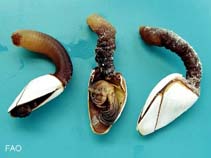Lepas anatifera Linnaeus, 1758
Duck barnacleWarning: DOMDocument::load(): SSL operation failed with code 1. OpenSSL Error messages: error:140770FC:SSL routines:SSL23_GET_SERVER_HELLO:unknown protocol in C:\Apache24\htdocs\includes\SpeciesSummary.lib.php on line 1236
Warning: DOMDocument::load(): Failed to enable crypto in C:\Apache24\htdocs\includes\SpeciesSummary.lib.php on line 1236
Warning: DOMDocument::load(https://sealifebase.nrm.se/webservice/AquaMaps/getAMap.php?genus=Lepas&species=anatifera): failed to open stream: operation failed in C:\Apache24\htdocs\includes\SpeciesSummary.lib.php on line 1236
Warning: DOMDocument::load(): I/O warning : failed to load external entity "https://sealifebase.nrm.se/webservice/AquaMaps/getAMap.php?genus=Lepas&species=anatifera" in C:\Apache24\htdocs\includes\SpeciesSummary.lib.php on line 1236
Classification / Names Common names | Synonyms | CoL | ITIS | WoRMS
Thecostraca | Scalpellomorpha | Lepadidae
Environment: milieu / climate zone / depth range / distribution range Ecology
Pelagic; depth range 0 - 75 m (Ref. 105990). Tropical; 81°N - 57°S, 179°W - 180°E
Distribution Countries | FAO areas | Ecosystems | Occurrences | Introductions
Circumglobal (76°N to 57°S): Indian Ocean, Europe, California to Panama, Japan, Philippines, Australia , North America, northern Gulf of Mexico to Brazil and Argentina.
Length at first maturity / Size / Weight / Age
Maturity: Lm ? range ? - ? cm
Pelagic (Ref. 99821). Found on buoys and floating objects (Refs. 2767, 7484, 85157) and grows on cork lifebelt (Ref. 3534). Also on keel of ships and driftwood. Known as a fouling species (Ref. 81749). Nonselective filter feeder; opportunistically ingests an array of zooplankton and fills its gut with sand when stranded on the beach. Readily ingest large prey up to 5 mm in diameter (Ref. 106994).
Life cycle and mating behavior Maturity | Reproduction | Spawning | Eggs | Fecundity | Larvae
Members of the superorder Thoracica are mostly hermaphroditic. Broadcast spawners, fertilization occurs in the mantle cavity. Life cycle: Eggs hatch into planktonic nauplii and leave the mantle cavity. Afterwards, they undergo six naupliar instars succeded by nonfeeding cypris larva (settling stage) which later metamorphose into adults.
Main reference
References | Coordinator | Collaborators
Young, P.S. 1998. (Ref. 3549)
IUCN Red List Status (Ref. 130435)
CITES status (Ref. 108899)
Not Evaluated
CMS (Ref. 116361)
Not Evaluated
Threat to humans
Human uses
Fisheries: commercial
| FishSource |
Tools
More information
Age/Size
Growth
Length-weight
Length-length
Morphology
Larvae
Abundance
Growth
Length-weight
Length-length
Morphology
Larvae
Abundance
Internet sources
BHL | BOLD Systems | CISTI | DiscoverLife | FAO(Publication : search) | Fishipedia | GenBank (genome, nucleotide) | GloBI | Gomexsi | Google Books | Google Scholar | Google | PubMed | Tree of Life | Wikipedia (Go, Search) | Zoological Record
Estimates based on models
Preferred temperature
(Ref. 115969): 8.8 - 28.9, mean 25 (based on 3094 cells).
Price category
(Ref. 80766):
Unknown.



